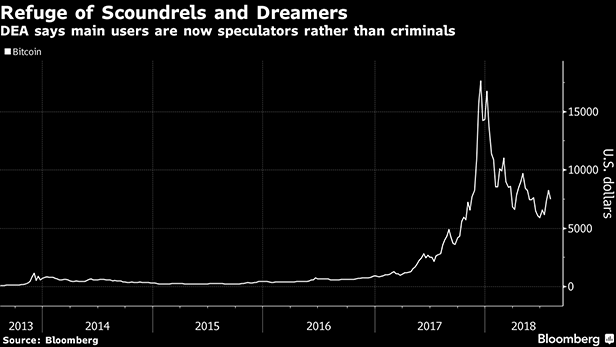The ratio of legal to illegal activity in conducted in bitcoin has flipped, according to Lilita Infante at the U.S. Drug Enforcement Administration (DEA).
When Infante started seeing the bitcoin pop up in her cases at the DEA five years ago, her analysis of blockchain data showed criminal activity was behind about 90 percent of transactions in the cryptocurrency. Now, illegal activity has shrunk to about 10 percent and speculation has become the dominant driver, she said.
That doesn't mean criminals stopped using bitcoin. Total transaction volume associated with illegal uses has surged since 2013, said Infante, who is a DEA special agent and part of the 10-person Cyber Investigative Task Force. The team focuses on dark web and virtual-currency related investigations and collaborates with other Department of Justice units including the Federal Bureau of Investigation and the Bureau of Alcohol, Tobacco, Firearms and Explosives.
Recommended For You
“The volume has grown tremendously, the amount of transactions and the dollar value has grown tremendously over the years in criminal activity, but the ratio has decreased,'' she said in an interview at her office in Weston, Florida. “The majority of transactions are used for price speculation.''

Infante's findings contradict the popular perception that bitcoin is mostly being used by criminals such as the notorious Dread Pirate Roberts, but also show that the underground market is one of the biggest groups of people using bitcoin for its actual features rather than its price gyrations. Transactions are pseudonymous, so not easily traceable, while a decentralized ledger eliminates the need for banks and governments, and also means there's no company that can be subpoenaed in an investigation.
The dark web, where illegal goods are sold, functions exclusively in cryptocurrency, as has been the case for years, she said. What's become a growing trend in the past year is that criminal organizations, like drug cartels, are increasingly using digital currencies across their operations, from money laundering to cross-border transfers, as it's cheaper, faster, and perceived to be more secure than going through the banking system, Infante said.
It's a double-edged sword for criminals though, as law enforcement is using blockchain technology to its advantage. Bitcoin and other blockchains are public and immutable, providing a valuable resource for agents to track transactions and patterns, and while wallet addresses once obscured users' identities, Infante said, “not anymore.''
Though users sometimes will exchange bitcoins for other coins with lower fees and faster transaction times to transfer funds, the overwhelming majority of dealings are still in bitcoin. Privacy-focused cryptocurrencies like Monero and Zcash aren't liquid enough and while they're more anonymous than bitcoin, “we still have ways of tracking them,'' Infante said.
Traffickers and money launderers exchange bitcoins for fiat currencies in over-the-counter and peer-to-peer exchanges, though they also go through major U.S.-based exchanges, Infante said.
Infante said criminals will likely continue using cryptocurrencies, but that's fine with her. “The blockchain actually gives us a lot of tools to be able to identify people,'' she said. “I actually want them to keep using them.''
From: Bloomberg
© 2025 ALM Global, LLC, All Rights Reserved. Request academic re-use from www.copyright.com. All other uses, submit a request to [email protected]. For more information visit Asset & Logo Licensing.




